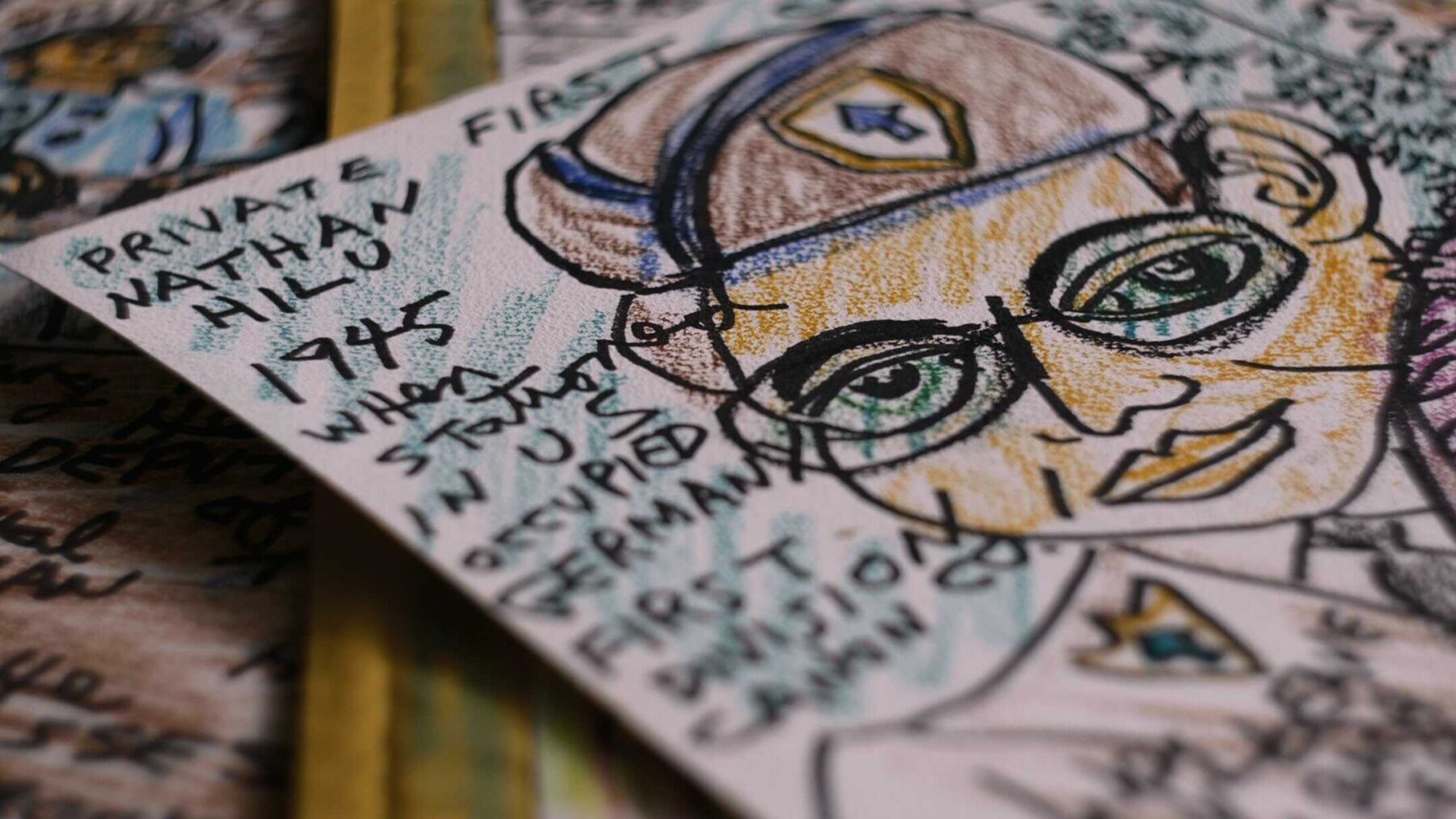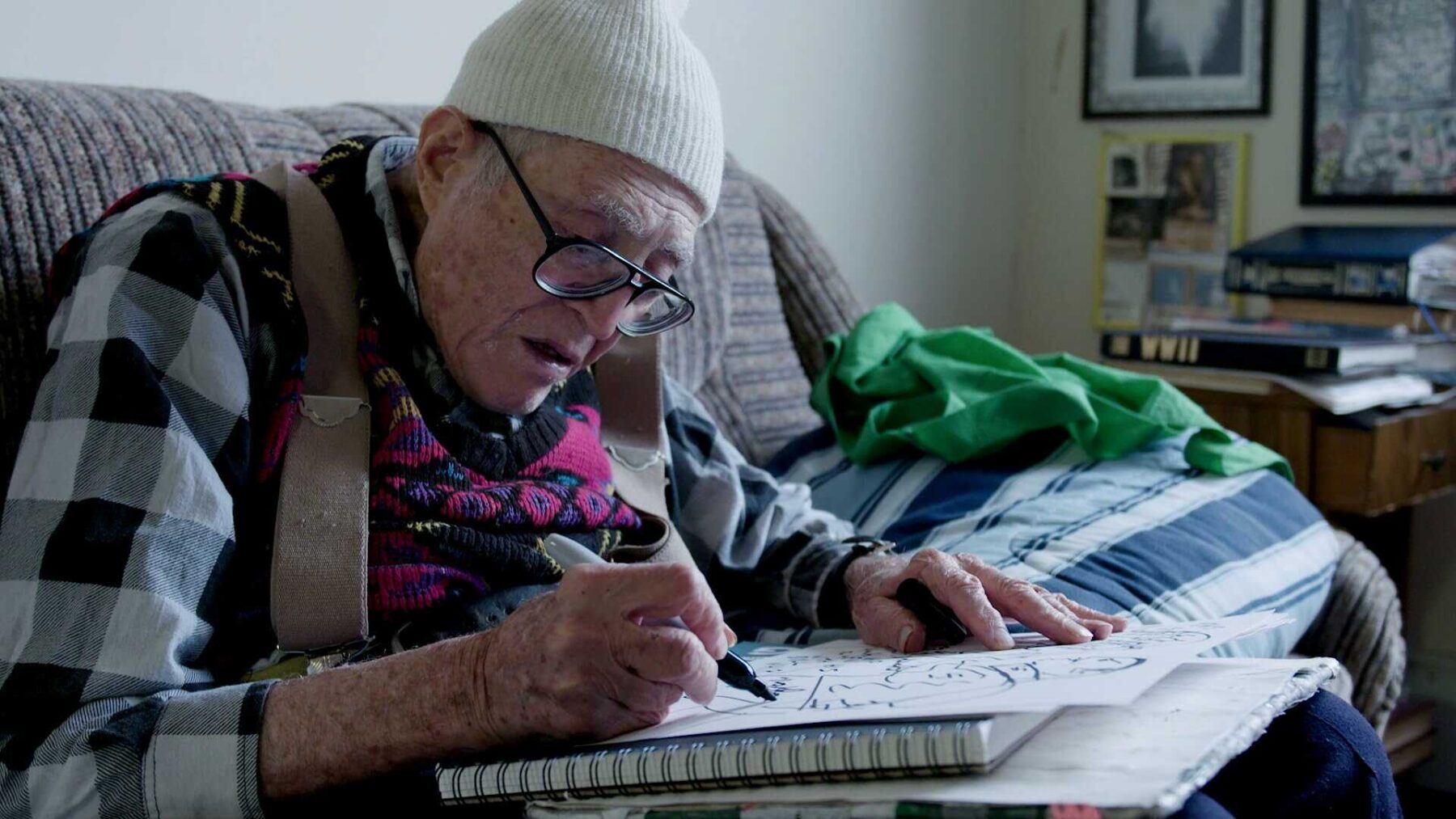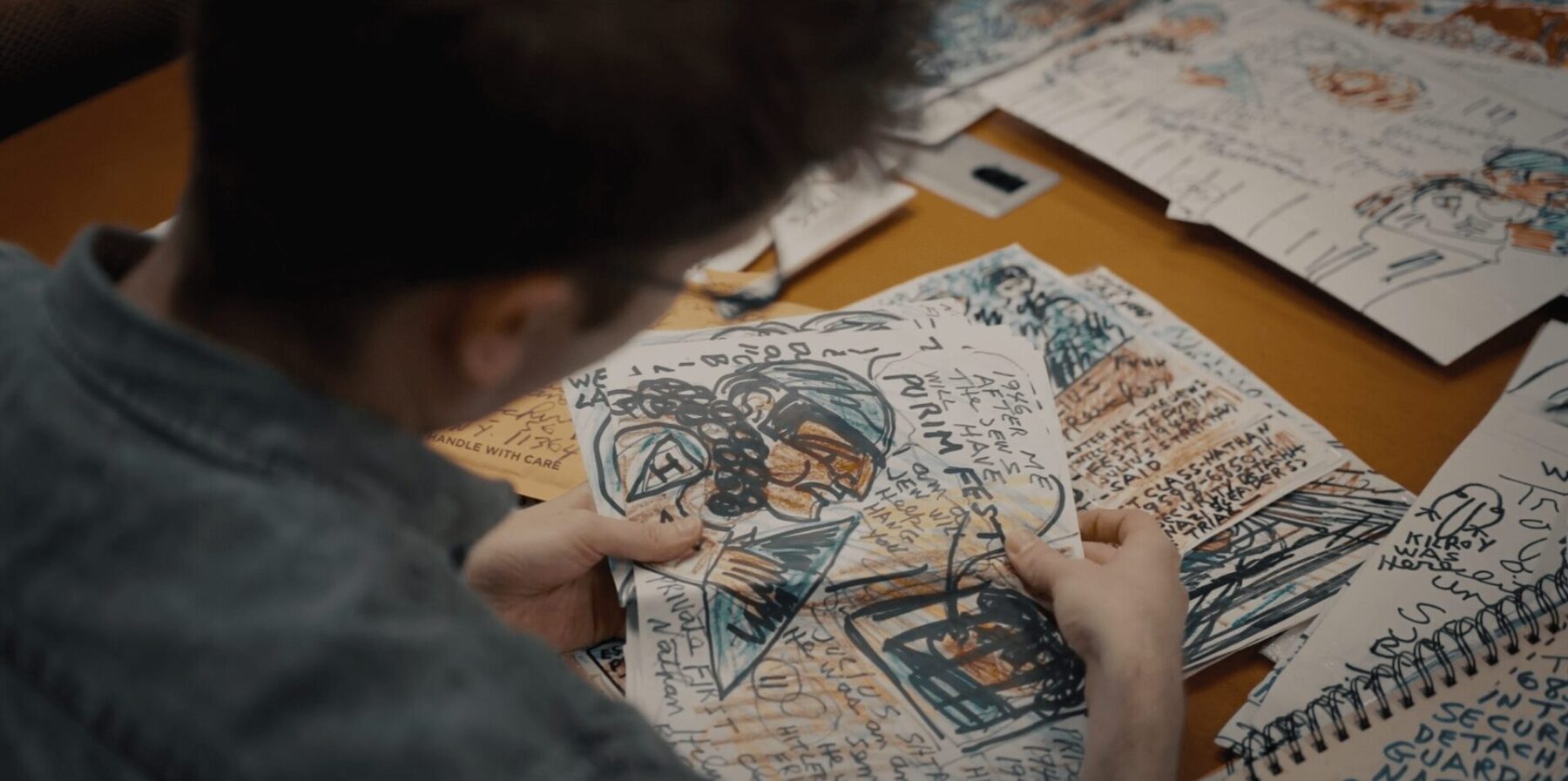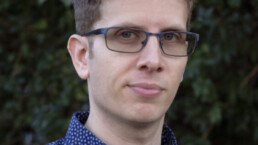With his large eyeglasses, thick suspenders, and slumped posture, Nathan Hilu may appear at first glance to be just an elderly man on a couch. But by looking closer, intentionally listening, and putting a camera in front of him, we learn that he’s a man not only rich in stories but with an abundance of artwork that illustrates pivotal moments in world history. And bringing this man’s life and stories to the screen is Elan Golod, director of the new documentary, Nathan-ism.
Nathan-ism tells the life story of Nathan Hilu, a Jewish veteran who guarded the worst criminals responsible for the Holocaust following WWII. But as the documentary reveals more about the expressive Nathan through seeing him sketch his quickly drawn cartoons–capturing monumental life moments relying on memory alone–we also learn that there may be some questions as to the authenticity of the stories as Nathan remembers them.
Related: ‘Nathan-ism’ Explores Truth and Narrative Through This Cartoonist
In our exclusive interview, Elan Golod shares the process and challenges of making Nathan-ism, the film’s upcoming screening at the Nuremberg Memorial (“It’s incredibly gratifying that Nathan will have his story shared in the very room where many details about the Holocaust were brought to light”), and the biggest takeaway after making the film and working in independent filmmaking.
How did you first learn about Nathan Hilu, the subject of your documentary and directorial debut, Nathan-ism?
I was going down the internet rabbit hole searching for potential documentary-worthy stories and I came across an article in a small Jewish magazine about Nathan Hilu and an exhibition he had had at the Hebrew Union College Museum. I was immediately struck by the dramatic circumstances of his Nuremberg experiences.
I was also intrigued by the cognitive dissonance of this heavy subject matter treated in these vibrant Crayola colors, unlike much of the existing canon of Holocaust-related art. That felt inherently cinematic and worthy of deeper exploration of the person behind these visual memoirs.

At the beginning of your film, Nathan shares that there are many art “isms”: Futurism, Impressionism, and now, “Nathan-ism.” How would you describe the “Nathan-ism” art style to audiences?
If “Nathan-ism” were featured in art history books it would probably be defined something like this: Rooted in the expressive storytelling of individuals like Nathan Hilu, this distinctive approach involves the skillful translation of personal narrative into a vibrant visual language, creating a unique fusion of storytelling and artistic expression that immerses viewers in the intimate and vivid landscapes of individual memories.

At first glance, Nathan’s art might appear amateurish and childlike to viewers, made with markers and crayons. But they are deceptively deep once you see that the cartoons are his life’s memories, specifically of being a Jewish prison officer guarding the highest-profile criminals of the Holocaust during the Nuremberg trials. What do you find striking about the juxtaposition between his playful cartoons and their grave historical subject matter?
To me, Nathan’s drawings offered a unique opportunity to convey a narrative linked to the Holocaust from a fresh perspective, diverging from the conventional portrayal often seen in previous Holocaust films. So much of the visual documentation of the Holocaust is in black and white which leaves the viewer somewhat removed. In stark contrast, Nathan’s artwork feels like it is bouncing off the page and screaming at you with the same urgency as Nathan’s storytelling style.
What were the first steps you took to begin this project?
After reading about Nathan Hilu online, I reached out to Laura Kruger, the curator of the Hebrew Union College Museum. She provided me with Nathan’s contact info but warned me that he was “quite the character” and that he wasn’t the easiest to deal with.
I cold-called Nathan and explained my interest in documenting his story. Initially, it took some time to gain Nathan’s trust and get him on board with the project. I visited him over several months without any camera or recording equipment, just sitting and listening to his stories over coffee. Nathan was very excited to have a willing audience for his stories and eventually felt comfortable enough to start sharing his stories on film.

What was the process like to bring Nathan’s artwork to life using animation?
From the outset, I felt that harnessing Nathan’s vibrant artwork with the right animation treatment could authentically immerse viewers in his deeply subjective perspective. During the conceptualization phase, I stumbled upon the work of Héloïse Dorsan Rachet, a Paris-based animator who had done beautiful animation sequences for Michelle Steinberg’s documentary “A Place to Breathe.” Rachet’s animation style, with its childlike and innocent quality, left me convinced she could effectively replicate Nathan Hilu’s unique artistic flair.
To ensure the animations stayed true to Nathan’s original work, we embarked on an extensive series of animation tests, prioritizing authenticity above all. Nathan’s abundant drawings, featuring key figures from the trial and pivotal scenes within the narrative, served as an invaluable visual foundation guiding our meticulous animation process.
What challenges did you face while making the film?
My relationship with Nathan was not the traditional filmmaker-subject relationship. While Nathan’s personality added a captivating layer to the narrative, it also posed occasional challenges during the filmmaking process. Each time we filmed with Nathan, it was like a “show-and-tell” session in which Nathan shared the stories behind his last batch of drawings. Nathan was very much intent on crafting his narrative, leaving little room for interjecting questions. Here and there, by curating the drawings I had him talk about, I was able to steer the conversation towards the topics I wanted to cover.
For the research about Nathan’s military service, I was unsure what our digging would unearth. At times it was a struggle to wait patiently while our archival research attempted to shed more light on Nathan’s time in Nuremberg. But as viewers will see in the film, the patience paid off.

As you just touched upon, the film takes an unexpected turn when it’s brought into question whether or not Nathan actually lived each of these experiences as he says he witnessed. This being a documentary, and you being so close with Nathan as a person, what was it like for you to include this part in the film?
This is an aspect I discussed extensively with my therapist. Navigating the intricate relationship between my roles as both a filmmaker and Nathan’s friend demanded a delicate balance. I intended to thoroughly delve into Nathan’s life story and delve into the depths of his psyche while avoiding the risk of putting his memory on trial in the process.
This required a nuanced approach, where our friendship served as a foundation for trust, allowing the exploration of his narrative with sensitivity and respect. I’m thankful to say that despite some tense moments featured in the film, I managed to maintain my friendship with Nathan until the very end.
Nathan-ism will have a special screening at the Nuremberg Memorial on February 13th. What does having this screening at such a sacred site mean for you?
I am truly humbled by this honor and I’m beyond excited that Nathan’s legacy and this film will have such a full-circle moment. It’s incredibly gratifying that Nathan will have his story shared in the very room where many details about the Holocaust were brought to light. In 1945, the four allied powers behind the Nuremberg trials had hoped that the trials would deter future aggression by establishing a precedent of holding war criminals accountable in international court. So it is very unusual and timely to showcase this film as conflicts persist in the Middle East and Ukraine

What would you say is the biggest thing you learned from Nathan, and what do you hope people take away from the film?
The most actionable lesson I learned from my time with Nathan is taking the time to listen. There are so many elders like Nathan, who have an abundance of remarkable stories waiting to be unraveled. Taking the time to truly listen not only honors their wealth of wisdom but also forges meaningful connections that transcend generational boundaries. In a world bustling with noise, dedicating moments to absorb and cherish the narratives of our elders becomes a powerful act, unlocking a treasure trove of experiences that might otherwise be lost to time.

Let’s get to know you better! Elan, where are you from, and how did you get your start in filmmaking?
Raised in Israel to an American mother and Israeli father, my journey unfolded with an unexpected twist as I found myself creating training videos as part of my mandatory service in the Israeli army. Post-army, I pursued a deeper understanding of filmmaking at New York University and went on to work as a film editor on both scripted and documentary films. This collaborative learning experience has significantly shaped my directorial approach.
What have you learned about working in indie film, and what did you wish you knew before you began?
Unfortunately, I’ve become increasingly aware of the challenges facing the documentary filmmaking landscape, with market trends narrowing the range of documentaries able to secure distribution. Nevertheless, I maintain a hopeful outlook for the emergence of fresh opportunities for daring documentary content, and I am determined to actively contribute to this essential transformation.
What messages and themes are important to you that you wish to explore in your future work?
I am currently deeply intrigued by the concept of legacy and the imprint we leave on the world long after we’re gone. At the moment I’m starting to explore a story related to this idea from within my own extended family.
For updates and more information on ‘Nathan-ism,’ head to the film’s website.

